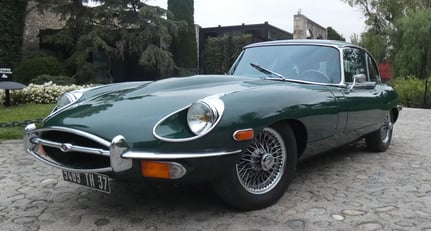1970 Jaguar E-Type SII
-
Year of manufacture1970
-
Car typeCoupé
-
Chassis numberP1R42867
-
Lot number58
-
ConditionUsed
-
Number of doors2
-
Number of seats4
-
Location

-
Exterior colourGreen
-
Fuel typePetrol
Description
"Serial number P1R42867
Same owner since 1992
Nice aesthetic and mechanical condition
Sculpture on wheels
French title
Known to all, the history of the Jaguar E-Type is an automotive success story that is now elevated to the rank of myth. Presented in 1961 to the general public, the first version of the feline turns the heads of all enthusiasts, collectors and the curious; it is adored by the critics and worries the biggest names of the sports car of the 1960s. With its unbeatable price-quality ratio, the Series 1 sold more than 38,000 units, a large part of which were sold in the United States.
At the end of the 1960s, the road safety committees in the United States began to point the finger at the E-Type, describing it as dangerous; to counter this and to avoid losing the most important market for its model, Jaguar unveiled a stylistic and mechanical evolution of its best-seller under the name ""Series 2"", which came just after the unofficial ""1.5"" series.
The most notable aesthetic evolution of this new series is the enlargement of the rear lights and the modification of the front lights, thus eliminating the famous glass bubbles. The series II remains a sculpture on wheels which is more pleasant to drive than its predecessor. As for the first series, a coupe and a cabriolet version will be produced between 1968 and 1970, powered only by a 4.2L inline 6-cylinder engine. In order to pass through the anti-pollution norms in force in the United States, this engine will be fed on the other side of the Atlantic, by Zenith-Stromberg carburetors, reducing its power by 100 horsepower.
The Series II will be replaced in the early 1970s by the Series III which will innovate mechanically and stylistically with the appearance of a more powerful and less polluting V12.
The car we present is a 1970 Series II in its FHC version (coupe) with two additional seats in the back. In a beautiful aesthetic and mechanical condition, this E-Type has kept its SU carburetors and allows it to keep all its horses. Equipped with a fully synchronized 4 speed manual gearboxes, this imposing coupe handles perfectly well in modern traffic. "













